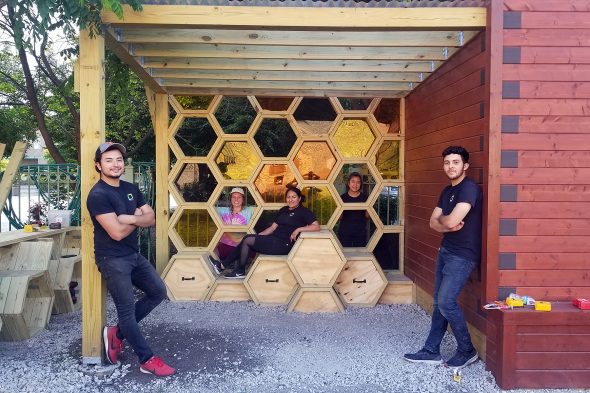Architecture students’ nonprofit aims to make big impact with small projects

When Paula Acevedo and her husband, Antonio, see neighbors relaxing among the monarch butterflies or hear the children playing in the El Paseo Community Garden that they run in Pilsen, they can’t help but be thankful to the University of Illinois at Chicago.
The Acevedos, who are directors of the garden, credit the school for helping to educate a group of students who created their own design and architectural nonprofit, Human Scale, which helped make their dream to expand the garden a reality.
“We are both grassroots organizations inspired by need, and what Human Scale does is it supports organizations like us because they are trying to give back to the community as well as we are,” said Paula Acevedo, who, with her husband, graduated from UIC in 2010. “It’s really exciting to be able to work with students who went to the same university we did.”
Human Scale began in 2018 after School of Architecture undergraduate students Walmer Saavedra, ’19; Aylen Pacheco, ’20; Kasia Pilat, ’20; Hsu Myat Aung, ’17; and Jorge Luis Mayorga, ’17 began working on projects together and realized they shared a common passion for community service.
Taking their love of service to their communities a further step, they decided to form their group because they wanted to make a realistic impact in their communities by using the skills they were learning in their UIC architectural courses to build small-scale projects, according to Saavedra, who is graduating from UIC on Dec. 14.
“Our focus was on doing small-scale projects because they’re affordable and they’re quick to build,” said Saavedra. “We want our designs to be designs that people take ownership in.”
Their mission is to make a positive impact in their neighborhoods by “designing and building community projects for those organizations that deliver a civic benefit to their members.”
“We wanted to create something where we could actually make an impact using the skills that we learned in architecture,” said Saavedra. “If we can impact one life or a couple lives, that’s what we want to do and we find meaning in that.”
By establishing themselves as a nonprofit, they had the platform to address important issues while making it more feasible to secure funding for their projects. Their goal was to incorporate members of the community in the design process so that they could create a “human-to-human” collaboration to build meaningful and long-lasting projects, said Saavedra. They also created a website with more information.
“This initiative is exemplary of UIC’s mission to create access to excellence, as well as our students’ willingness to go above and beyond to achieve it,” said Judith DeJong, associate professor of architecture. “That these students do this work in addition to their full-time studies and/or employment is a testament to their tenacity and commitment to bringing high-quality design to wider audiences in Chicago.”
Since the nonprofit formed, several of the members have gone on to full-time employment with architectural and design firms, but they have maintained their role with the group. The number of projects they are working on has increased through word-of-mouth recommendations from community groups who have worked with them, such as El Paseo.
At El Paseo, they had design meetings with the Acevedos, who wanted to build an outdoor classroom for children. The result, which was funded through grants, was what they call, “The Hive,” an expansion to the garden that includes an outdoor classroom, café stand, storage shed, benches, tables, cubbies and a chalkboard. Paula Acevedo said the community has embraced the expansion, and they want to install solar panels to the structure.
They plan to continue working with the group and are in the process of meeting with them to design and build accessible flower/vegetable beds and a new picnic area.
“We’ve had a very positive experience with them — so much so that we are working with them again,” Paula Acevedo said.
In the Austin neighborhood, the group is working with Patricia and Robert Hart, who created the Hart Peace Community Garden on three abandoned lots they purchased from the city.
Patricia Hart said the garden began after the woman who had created the original garden passed away and there was a void in the community. Robert Hart, a military veteran who was suffering from PTSD after serving in the Iraq War, created the garden to help other veterans after he realized how much it helped him. His work with the garden has helped his PTSD so much that he has gone from five times a week meetings at the VA hospital to just once a month, said Patricia Hart.
The Harts are in the process of working with Human Scale to design a Pergola as well as a shed and walkways so seniors and others can take advantage of the green space and eat healthy, fresh vegetables.
“We wanted something positive in the neighborhood so people can come out and find some peace, smell some flowers and pick some fresh vegetables and eat healthy,” Patricia Hart said. “I think it’s a great thing they [Human Scale] are doing because otherwise, we can’t really afford to build it.”
